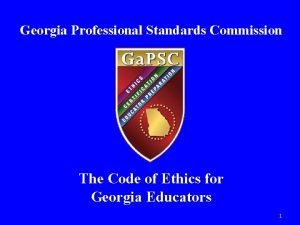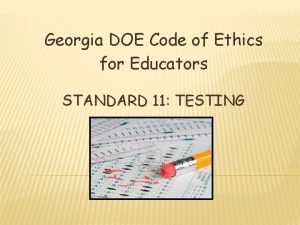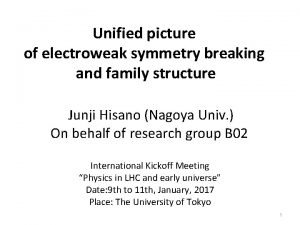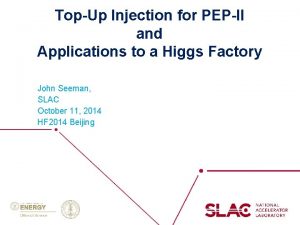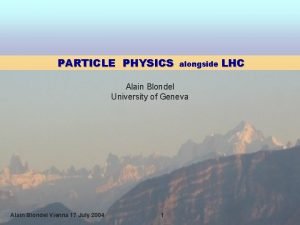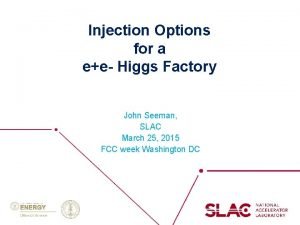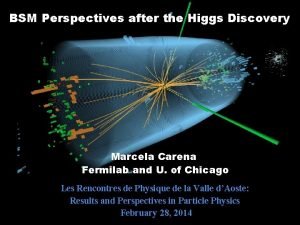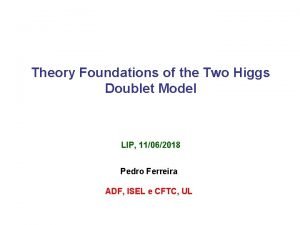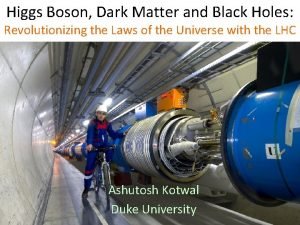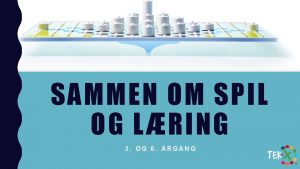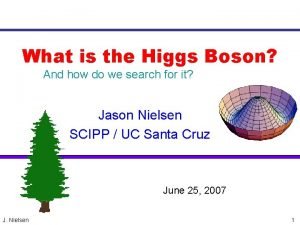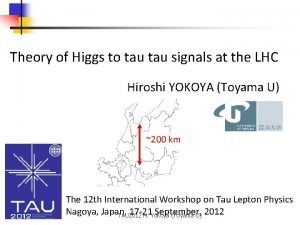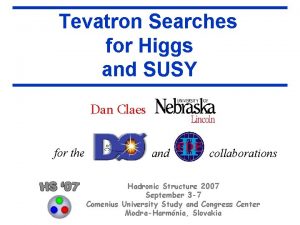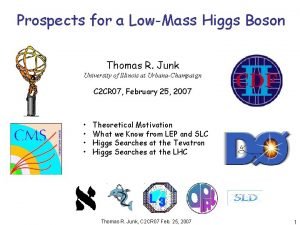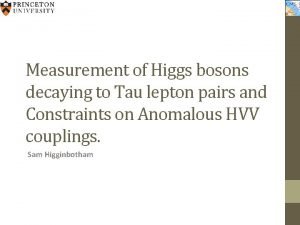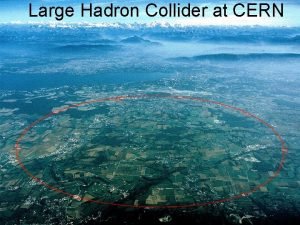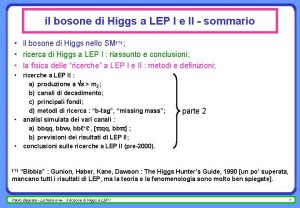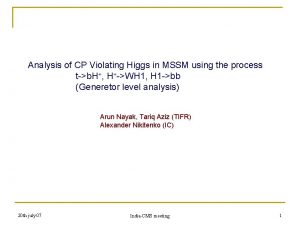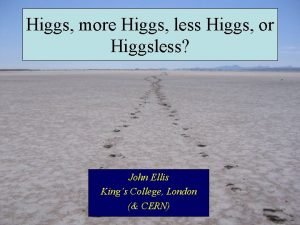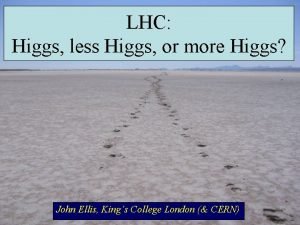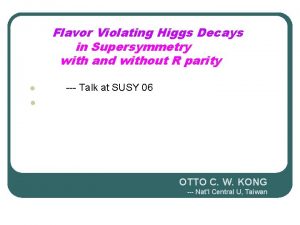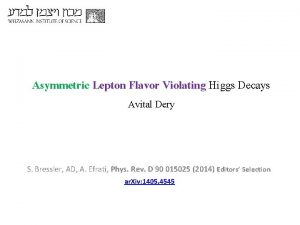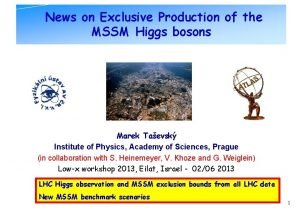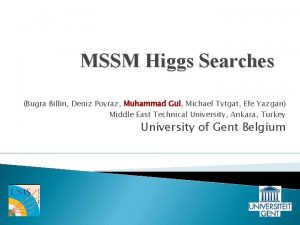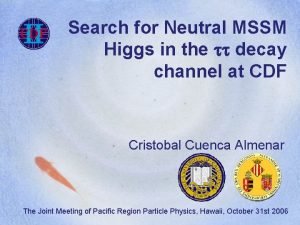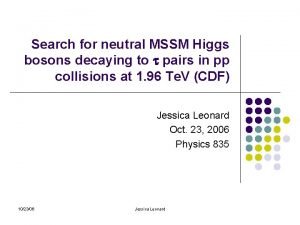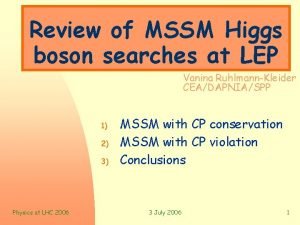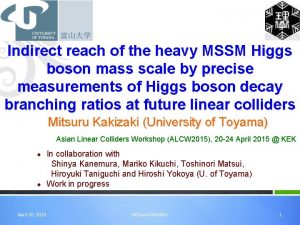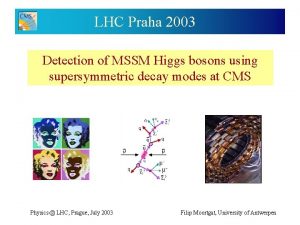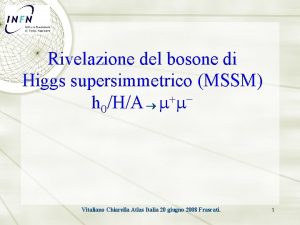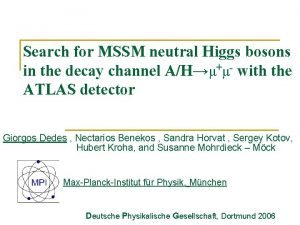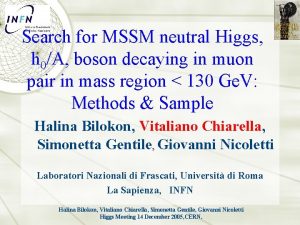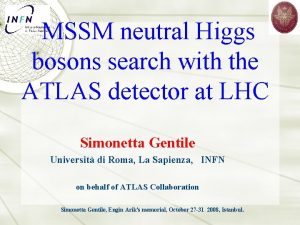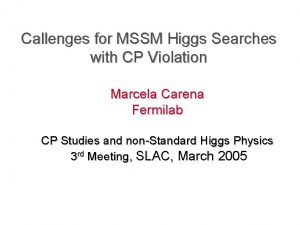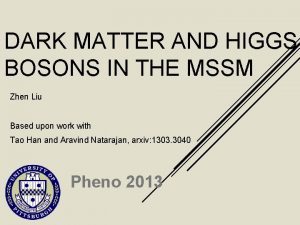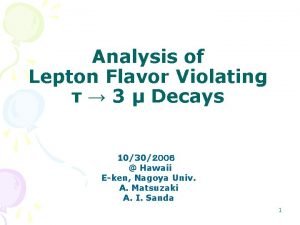Analysis of CP Violating Higgs in MSSM using




















- Slides: 20

Analysis of CP Violating Higgs in MSSM using the process t->b. H+, H+->WH 1, H 1 ->bb (Generetor level analysis) Arun Nayak June 07 (TIFR) Les Houches meeting 1

LEP limits for CPX scenario : Because of the suppressed H 1 ZZ coupling, LEP can not exclude the presence of a light Higgs boson at low tanb (~ 3. 5 to 10) (LEP Higgs working group, hep-ex/0602042) June 07 Les Houches meeting 2

Higgs Production in CPX scenario : Phenomenological analysis by Ghosh, Godbole, Roy hep-ph/0412193 Because of the suppressed H 1 VV coupling one of the pseudo-scalar Higgs state is very light Since there is correlation between the mass of charged Higgs and that of the pseudo-scalar Higgs state in MSSM, that implies a light charged Higgs, with MH+< Mt. A suppressed H 1 VV coupling implies increase in H 1 H+W coupling because of the sum rule g 2 Hi. VV + | g. Hi. H+W- |2 = 1 And that implies an increase in branching ratio of H+->H 1 W ( > 47% over the entire range) The traditional decay mode H+->tn is suppressed over an order of magnitude. Hence both light H 1 & H+ can be probed using this process pp -> t + t~ + X b. H+ b~W W H 1 qq~(ln) ln(qq~) bb~ June 07 Les Houches meeting (hep-ph/0412193) 3

Generator Level Analysis : Total no. of events generated : 260000 for signal, (~30 fb-1) (generated using Pythia) 100000 for ttbb background(~30 fb-1) 2000000 for ttjj background cross section : signal cross section : parameters : F(CP) = 90 o, tan(b) = 5 M(H 1) = 51 Ge. V, M(H+) = 133 Ge. V, M(top) = 175 Ge. V * BR = 2 * 840 pb (ttbar NLO cross section) * 0. 01(BR(t->b. H+), using CPsuper. H) * 0. 567(BR(H+->H 1 W), using CPsuper. H) * 0. 99(BR(t->b. W)) * 0. 92(BR(H 1 ->bb), using CPsuper. H) = 8. 675 pb ttbb bkg cross section : 3. 285 pb Generated using Comp. HEP with preselections : Pt(b)>15 Ge. V, | (b)|<3. , Delta. R(b 1, b 2)>0. 3, ttjj cross section : 506. 99 pb Comp. HEP generated events with preselections : Pt(j)>15 Ge. V, | (j)|<3. , Delta. R(j 1, j 2)>0. 3 June 07 Les Houches meeting 4

Reconstructions and selections: 1) The events were generated with all possible W decay. So the first selection was, the events with one W decaying to electron or muon and neutrino and other W decaying to 2 light quarks were selected. The final state now contains 4 b quarks, 2 light quarks, one charged electron or muon, and missing energy due to neutrino. 2) jets reconstructed in pythia using parameters MSTU(51)=100 , no. of eta bin MSTU(52)=70 , no. of phi bin PARU(51) =5. 0 , total eta range PARU(52)=0. 1 , tower threshold PARU(53)=20 , jet Et threshold PARU(54)=0. 5 , cone size 3) events with Pt(b-quarks)>20 Ge. V, | (b-quarks)|<2. 5 selected. events with 6 or more jets has been selected, b-jets found by matching jets to b-quarks in 0. 4 cone, events with 4 b-jets found are considered. Remaining jets are treated as light quark jets. June 07 Les Houches meeting 5

4) Missing Et reconstructed from jets and charged lepton. By adding transverse momenta of jets and leptons vectorially. 5) one W reconstructed from charged lepton and missing Et. W boson momentum and energy calculated applying constraint on W mass as 80 Ge. V. This gives two solutions. Incase the solutions are imaginary, the event is neglected. 6) other W reconstructed from two light jets. Two light jets pair chosen from all possible combination of pair of light jets(if more than 2 light jets present) where the di-jet invariant mass lies within 65 to 95 Ge. V. If more than one jet pair fall within this mass window, the pair with invariant mass close to 80 Ge. V has been considered. 7) One top quark reconstructed from one of the b-jets and one of the W. total 12 combinations for quadratic ambiguity on W reconstruction from lepton and missing ET. The pair with inv. mass close to 175 Ge. V and within 150 to 200 Ge. V has been considered. June 07 Les Houches meeting 6

8) If the W used in 1 st top reconstruction is one of Ws from ln, then the other one has been considered as the wrong one and was neglected. On the other hand if the W used in 1 st top reconstruction is from light jets, then there is quadratic ambiguity in the 2 nd top reconstruction. 9) other top has been reconstructed from remaining 3 b-jets and remaining one W. (If quadratic ambiguity in W reconstruction and the W used in first top reconstruction is from light jets, then there are two combinations for 2 nd top. The one close to top mass has been considered) The inv. mass cut for bbb. W is 150 to 200 Ge. V. 10) H 1 reconstructed from two b-jets ( out of 3 -bjets in 2 nd top, total 3 possible combinations. ) 11) As seen in figure, peak of H 1(2 -bjets) mass distribution (distribution includes all backgrounds and also combinatorial backgrounds) lies around 50 Ge. V. So H 1( or 2 -bjets) with inv. mass close to 50 and falls within 35 to 65 Ge. V was used for H+ reconstruction. H+ has been reconstructed from H 1 and W (in 2 nd top). June 07 Les Houches meeting 7

Top & W mass reconstruction : The plots shows the reconstructed W mass for W->jj, and top mass for t->bln & t->bjj The combinations with inv. mass close to W or top mass has been considered. For t->bjj case, a mass window for jj inv. mass has been applied. 65 Ge. V < mjj < 95 Ge. V June 07 Les Houches meeting 8

Full simulation Jets using Iterative cone algorthim with cone size 0. 5 ( , f) June 07 Les Houches meeting 9

Top mass contd…. Distribution of top mass for t->bbbln & t->bbbjj , the combination with inv. mass close to top mass was considered. For t->bbbjj case, a mass window on jj inv. mass was applied. 65 Ge. V < mjj < 95 Ge. V June 07 Les Houches meeting 10

H 1 & H+ mass reconstruction : Reconstructed mass of H 1(2 b jets) & H+(2 b jets and W). Plot includes both signal and background events. All combinatorial backgrounds are also included in 2 b-jet (H 1) inv. mass Two b-jets with inv. mass close to peak of H 1 mass distribution and lies within 15 Ge. V around the peak were considered for H+ reconstruction. Plots for 30 fb-1 data June 07 Les Houches meeting 11

p. T difference of b-jets 2 lowest p. T b-jets June 07 Les Houches meeting 12

ttjj background analysis : selection of events similar to the signal events, one W-> lnu and other W->2 jets. Here the final state consists two b-jets from two top quark, atleast 4 light quark jets, one charged lepton. One W reconstructed from charged lepton and mising Et with W mass constraint. Other W from two light jets( making all possible combination), W mass window 65 to 95 Ge. V. One top reconstructed from one of two b jets and one of two (or three) W. Out of remaining light jets, two jets are selected as b-jets (to do a fake mis tagging) Assuming a maximum possiblity, two light jets which in combination with remaining one b and remaining one W gives the best top mass (within 175 ± 25 Ge. V), has been used as two b-jets. | |(two selected jets)<2. 5 Since I put a mass window on bbb. W, I select 2 -fake b-jets in this way. other light jets, if taken (mis tagged) as b-jets, will not survive in the selection cuts. This way of choosing two fake b-jets maximise the possible background from ttjj events. June 07 Les Houches meeting 13

Now there are 4 b-jets (including two fake b-jets), so one can reconstruct two top and H 1 and H+ using the same procedure as signal events with same mass window for top, W and H 1. Since two fake b-jets has been considered, we multiply a constant (corresponding to mistagging rate) to the final selected events. Assuming that mistagging rate per jet is 1%, for two jets to be mistagged, a constant 0. 01*0. 01 = 0. 0001 is multiplied to final selected ttjj events. We assume a 50% b-tagging efficiency per jet. So we multiply a factor of 0. 0625 (efficiency for tagging 4 b-jets) to signal and ttbb events and 0. 25(efficiency for tagging 2 b-jets) to ttjj events. Cross section of events after final selections : (i. e. no. of events in H+ mass distribution plots) signal : ~ 1. 063 fb ttbb bkg : ~ 0. 051 fb ttjj bkg : ~ 0. 0296 fb June 07 Les Houches meeting 14

Signal & background contribution : The major background to 2 b-jet invariant mass comes from the combinatorial backgrounds which may make the distribution very wide and have long tail. But a clear peak on top of it helps to chose the correct b-jet pair for the H+ reconstruction. Plots for 30 fb-1 data June 07 Les Houches meeting 15

Selection details Cross W ln | (b)| section & < 2. 5 pb W qq PT(b)> 20 Ge. V (no. of events) Atleast 6 jets 76100 14265 signal 8. 675 17803 4 b-jets matched to bquarks Reco W(l+MET) & W(2 jets) 65<mjj<95 6579 2634 Top H 1 (b-jet +W) 150<mt <200 (3 b-jets + W) 150<mt <200 (2 b-jets) 35<mh 1 <65 2529 515 510 1. 063 fb (260000) ttbb 3. 285 29037 15563 13124 6672 2242 2212 27 0. 051 fb (100000) ttjj ** 506. 99 (2000000) 564403 458889 25 389639 340402 (2 b-jets only) 166713 152193 5109 4675 0. 0296 fb multiply b-tag efficiency factor to final selected events to get the final state cross section June 07 Les Houches meeting 16

Simultaneous Top Reconstruction Minimize sqrt((mrec(t->b. W) – mtop)2 + (mrec(t->bbb. W) – mtop)2) signal Cross W ln | (b)| section & < 2. 5 pb W qq PT(b)> 20 Ge. V (no. of events) Atleast 6 jets 76100 14265 8. 675 17803 4 b-jets matche d to bquarks 6579 Reco W(l+MET) & W(2 jets) Top H 1 (3 b-jets + W) 150< mt < 200 (2 b-jets) 65<mjj<95 (b-jet +W) 150 < mt <200 2634 1793 892 879 1. 832 fb (260000) ttbb 3. 285 29037 15563 13124 6672 2242 1074 58 51 0. 104 fb (100000) June 07 35 < mh 1 < 65 Les Houches meeting 17

Backups June 07 Les Houches meeting 18

Separation of two b-jets used to reconstruct H 1 June 07 Les Houches meeting 19

June 07 Les Houches meeting 20
 Georgia educator code of ethics
Georgia educator code of ethics Prc br435 – code of ethics for professional teachers
Prc br435 – code of ethics for professional teachers Code of ethics for educators georgia
Code of ethics for educators georgia Penalties for violating fwa laws
Penalties for violating fwa laws Higgs singlet
Higgs singlet Scence
Scence Higgs factory
Higgs factory Higgs factory
Higgs factory Higgs singlet
Higgs singlet Higgs singlet
Higgs singlet Higgs doublet
Higgs doublet Higgs boson black hole
Higgs boson black hole Chelsea higgs wise
Chelsea higgs wise Hungry higgs brætspil
Hungry higgs brætspil Higgs boson
Higgs boson Higgs to tau tau
Higgs to tau tau Higgs
Higgs Higgs boson
Higgs boson Higgs
Higgs Higgs
Higgs Bosone di higgs
Bosone di higgs
